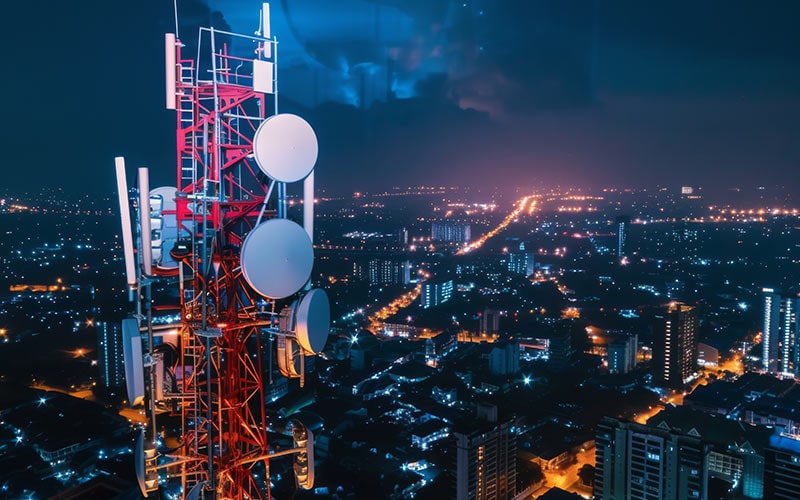Insights
- Viewers have been slow to come back to live sporting event broadcasts.
- Hyperconnected fans have more distractions and changed habits while sports was on hiatus.
- Second screens that are a distraction can be co-opted into enriching a sports broadcast experience.
- Using 5G and edge computing can give creators new avenues for engaging, enriched content.
- Network slicing techniques can handle spikes in usage demand and deliver premium and differentiated experiences at events and over the screen.
A slow return to sports viewership
On March 11, 2020, U.S. sports fans realized that COVID-19 was no longer an overseas problem.
On that day, the National Basketball Association (NBA) canceled a game between the Utah Jazz and Oklahoma City Thunder moments before tipoff due to a player’s positive coronavirus test. Of course, we now know that the virus had proliferated widely before that date, but the NBA cancellation of that game and the quick suspension of almost every major U.S. sports league made COVID-19 real for many Americans.
When the games resumed, however, viewership remained low for many live televised sports.1 Most recently, the Tokyo Summer Olympics faced the challenge of staging a global event with a worsening pandemic in many areas and the absence of athlete star power.2
These extrinsic problems exacerbated the structural challenges already facing televised live sporting events. Broadcast television is a 20th-century media format — a passive, one to many, linear experience — that now must compete with 21st-century media that is available on demand and often features interactions. Streaming viewership globally increased 44% year-over-year from Q42019 to Q42020.3 The number of streaming platforms in the U.S. multiplied, including the launches or relaunches of platforms by Disney, NBC, HBO, and CBS at the start of or during the pandemic. The bulk of e-gaming users say that online and interactive gaming has cut into the time they devote to viewing sports.4 Olympics broadcaster NBC took steps to address this by partnering with gamer streaming platform Twitch to add its own Olympics channel.5
Global streaming viewership increased 44% YOY from Q42019 to Q42020
In terms of easy-to-access and highly engaging on-screen entertainment, viewers have never had more options. Sports leagues and their media partners must find new ways to bring fans back to the broadcast sports experience. This new version must retain the authentic passion of live sports and deliver interactive engagement to match 21st-century digital media.
Delivering a hyperconnected experience
We now live in a hyperconnected world. The constant chatter on social media, the “dings” and “whizzes” of email notifications, video calls, new content, new streaming services, and new devices with super-crisp video have sprouted everywhere. These distractions have grown so ubiquitous that we have lost sight of what powers all the spread and all these experiences: the network. The network connects all the worldly visual and sensory experiences, like the arteries and veins of the human body.
For sports, the event organizers, leagues, and service providers need to think beyond what the event is and examine how spectators experience it. After all, event organizers, leagues, and service providers are all going to be held accountable by viewers and customers, especially if the events and experiences fall short of expectations.
Enriched events can convert viewers to fans
Streaming services need to develop a multipronged strategy that includes (1) content that drives social engagement and (2) an experience that is simple, interactive, and engaging.
Technology firms have already found ways to digitally enrich live sports. In May, Infosys collaborated with Roland-Garros (also known as the French Open) to connect viewers more closely to the socially distanced Grand Slam event. Immersive viewing features included interactive match data, 3D representations of shot locations, and insights generated by artificial intelligence (AI).6 Cloud technologies enabled broadcasters and journalists to instantly access video highlights and infographic-generating tools moments after a match. This in turn helped accelerate the delivery of match clips and editorials to fans on popular digital media platforms and drove greater engagement.7
Football and soccer are also looking for ways to better engage. The National Football League during its 2020 season collaborated with kids TV network Nickelodeon for an enhanced visual experience, adding the network’s trademark slime to the critical red zones and end zones of the field to attract new fans.8 Germany’s Bundesliga soccer league in 2020 used digital systems to highlight a new league speed record (22.7 mph across the pitch) set by then-19-year-old Canadian Alphonso Davies.9
These all are rich, high-bandwidth examples. Using the high speeds of 5G networks can deliver these richer experiences to fans at home and in the stands, enriching their experiences regardless of geography. And delivering these experiences to mobile devices gives users a simpler and more natural way to engage.
Web-scale networking brings streaming services to life
It takes more than cameras, software, and 5G to deliver a rich streaming experience. Sports media and their partners must develop web-scale networks to handle the demands of streaming large volumes of data and rich content to a constantly changing audience. Over time, producers will develop richer experiences that integrate application programming interfaces (APIs) with edge applications and services. As the experience grows richer, providers must develop web-scale networks to bring it to life.
Web-scale networking relies on an edge and 5G ecosystem that includes:
- Edge caching: last-mile caching, content delivery networks (CDNs), and edge processing.
- Content optimization: on-the-fly transcoding for each device, network, and user.
- Scalable back-end systems: horizontal scaling of ingestion, identity, and subscription systems.
- Delivery methods: on-demand utilization of 4G or 5G, mobile broadcast, and fixed satellite networks.
- Hyperpersonalization: tailored experiences driven by user feedback, AI, and machine learning (ML)-informed analytics.
Leaders in the content delivery industry have been discussing edge caching and edge computing for nearly two decades. Edge computing and CDNs are similar, but fundamentally different, technologies. One is not a replacement for the other — they are complementary. CDNs bring content closer to end users by placing servers at optimal locations. Edge computing moves applications, data, network traffic management, and data processing closer to end users.
In addition to the particular technology components, web-scale networks must be architected to be automated, open, and adjacent.
As the edge and 5G ecosystem matures, developers will need to rely more on automation and workflow orchestration. Edge computing will develop faster with a robust application ecosystem in place. The quickest method to develop such an ecosystem is to open it to the developer community in the form of an open edge system. Finally, placing edge computing assets in an operator’s last mile specifically with sports streaming and emerging 5G network support in mind creates the potential for a completely novel technology tool.
Figure 1. Infosys worked with Roland-Garros to deliver interactive match data during the annual Grand Slam tennis event
Source: Infosys
Manage usage spikes on game day with network slicing
With a fast network in place, tech providers should then use 5G network slicing architectures. This will allow for greater customization and flexibility. Some services (such as streaming TV and over the top offerings) require high throughput, while others (such as live sporting events) depend on extreme reliability. Network slicing allows the sports content and experience providers to deliver both high throughput and extreme reliability. Instead of building one jumbo network with excess capacity, providers build specific slices for each requirement.
Network slicing allows sports content and experience providers the flexibility to deliver experiences that require high bandwidth to a select few or extreme reliability to a broad audience
For example, content and experience providers might face dueling requirements during a live sporting event: High bandwidth is needed for the general public while high-fidelity 4K video must be delivered to television producers or VIP attendees. The operator can use slicing to provide resources to satisfy high demand at specific locations and high-fidelity 4K video at others. Figure 1 details the scenario in more depth.
Kickoff: A service provider launches a live stream of a competitive sporting event across a national footprint.
Spike: A sudden traffic spike strains the streaming service and back end systems.
Data collection: On-site data centers, remote data centers, and edge locations deliver analytics on traffic and latency conditions. On demand systems provision a media streaming network slice, leveraged 5G connectivity, and edge capabilities.
AI/ML analysis: An established analytics engine connects with an ML-based policy function to create new slices to manage increased traffic demand.
Slice: Policy functions use network slice management functions (NSMFs) to spin out edge-to-edge slices at the user plane function and deliver via prebuilt and standardized templates.
Streams: End users request sustained premium video streams via the mobile app. The user’s system shares video quality metrics (such as pixel density) with the application engine. The app engine matches with the subscriber’s profile and applicable video profile or the user adds a new subscription (such as higher video quality), so that the app engine delivers an on-demand scale-up of the user’s service. The app engine makes an API call to utilize a network slice to deliver premium streaming. The app engine connects to the ML-based policy function to provide a dedicated slice to the user.
Result: This superlative streaming service ensures that the fanatic sports user is fully immersed throughout the game experience.
Figure 2. Spike-slice-stream: How network slicing can support streaming sports
Tapping technology to enrich live sports streams
Sports media and their partners must recognize that the COVID-19 disruption was also an acceleration of change to the media landscape. Live televised sports remain compelling, but viewers expect more than just a passive experience. The lackluster ratings for this summer’s blockbuster sporting events provide evidence of this.
A richer, more connected experience can lure viewers back and convert them into fans. That renewed experience can be delivered through the collaborative innovation efforts of sports leagues, differentiated streaming services, and their technology and telecom partners. This requires delivering the sporting drama with timely insights via fast and adaptable web-scale networks. Edge computing and 5G telecom systems will provide the speed and network slicing architecture to handle spikes in usage.
With the right content and a fast, flexible system in place, fans will receive a better experience — with a second screen enriching the sports experience, not distracting from it.
References
- America Didn’t Need Sports After All, Jemele Hill, Feb. 28, 2021, The Atlantic.
- “Why LeBron James, Stephen Curry and other NBA stars skipped the 2021 Olympics,” Joe Rivera, July 27, 2021; “Serena Williams joins growing list of tennis stars to skip Tokyo Olympics,” June 27, 2021, Reuters; “Jordan Spieth joins list of top golfers skipping Rio Olympics,” July 11, 2021, CNN.com.
- “Conviva’s State of Streaming,” Q4 2020, February 2021, Conviva.
- “Are E-sports Eating Up Traditional Sports Viewership?,” Jamie Condliffe, Oct. 14, 2016, MIT Technology Review.
- “NBC is bringing some Olympic Games coverage to Twitch,” K. Holt, May 6, 2021, Engadget.
- Infosys Match Centre, retrieved June 25, 2021, Rolandgarros.com.
- Infosys Match Centre, retrieved June 25, 2021, Rolandgarros.com.
- “Best of NFL on Nickelodeon!,” Jan. 10, 2021, NFL Rush.
- “Bayern Munich’s Alphonso Davies sets new Bundesliga speed record,” June 2020, Bundesliga.com.







